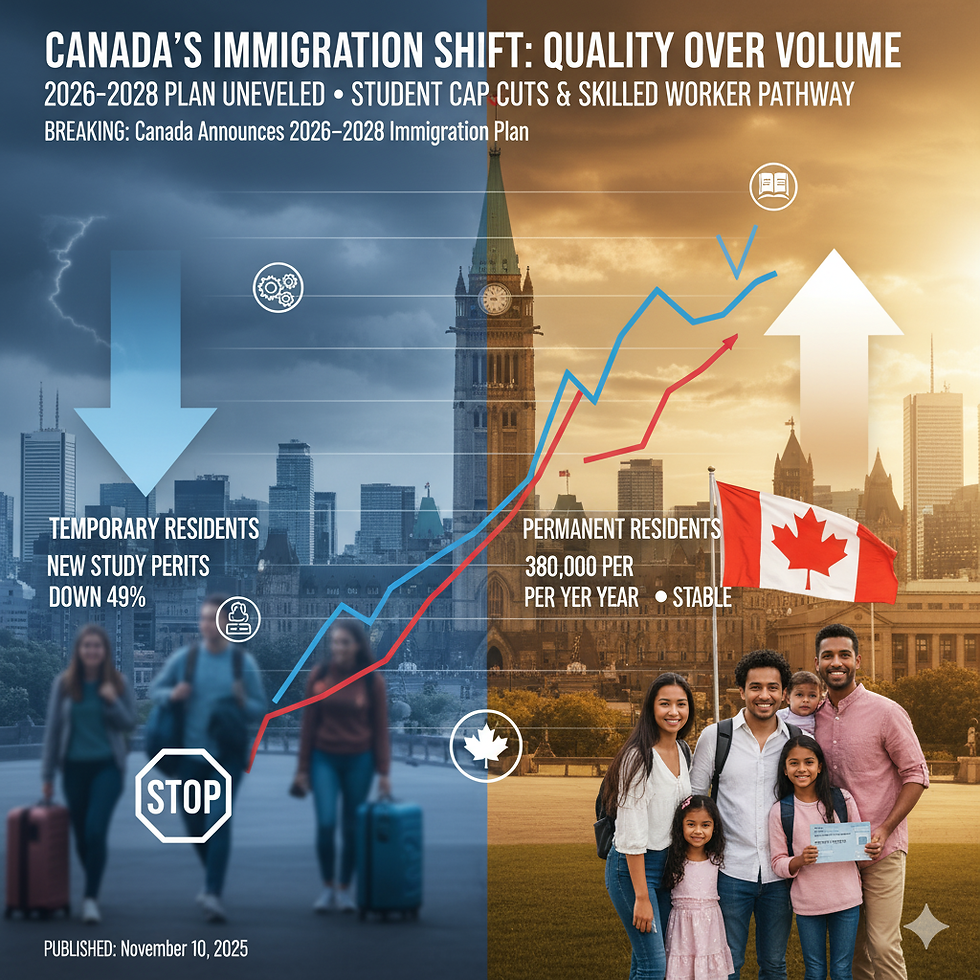Understanding the Difference Between Port of Entry and Visa
- Ansari Immigration

- Aug 2, 2024
- 5 min read
Planning to immigrate to Canada can be an exciting yet complex journey. One of the fundamental aspects of this process involves understanding the difference between a port of entry (POE) and a visa. While these terms are often used interchangeably, they serve distinct purposes in the immigration process. This blog aims to clarify these concepts, providing valuable information for prospective immigrants to Canada.
What is a Visa?
A visa is an official document issued by the government of Canada that allows you to enter, stay in, or transit through Canada. There are various types of visas, each serving different purposes:
Visitor Visa: For tourists, family visits, or short business trips.
Study Permit: For international students enrolled in Canadian educational institutions.
Work Permit: For individuals who have secured employment in Canada.
Permanent Resident Visa: For those who intend to live in Canada permanently.

Types of Visas
Visitor Visa
A visitor visa, also known as a temporary resident visa, is required for individuals who wish to visit Canada for a short duration. This visa can be single-entry or multiple-entry, allowing you to enter Canada once or multiple times within a specified period.
Steps to Apply for a Visitor Visa:
Determine Eligibility: Ensure you meet the eligibility criteria, such as having a valid passport, being in good health, and having no criminal record.
Complete the Application Form: Fill out the IMM 5257 form online.
Gather Supporting Documents: Include a passport-sized photo, proof of financial support, and a letter of invitation (if applicable).
Pay the Application Fee: The fee for a visitor visa is CAD 100.
Submit Biometrics: Provide fingerprints and a photo at a designated biometric collection point.
Wait for Processing: Processing times vary by country, so check the current processing times on the IRCC website.
Receive the Decision: If approved, you will receive a visa sticker in your passport.
Study Permit
A study permit is essential for international students who plan to study at a designated learning institution in Canada. It's important to note that a study permit is not a visa; you may also need a visitor visa or an electronic travel authorization (eTA) to enter Canada.
Steps to Apply for a Study Permit:
Obtain an Acceptance Letter: Secure an acceptance letter from a designated learning institution in Canada.
Complete the Application Form: Fill out the IMM 1294 form online.
Gather Supporting Documents: Include a valid passport, proof of financial support, and a letter of explanation.
Pay the Application Fee: The fee for a study permit is CAD 150.
Submit Biometrics: Provide fingerprints and a photo at a designated biometric collection point.
Wait for Processing: Processing times vary by country, so check the current processing times on the IRCC website.
Receive the Decision: If approved, you will receive a Port of Entry (POE) letter of introduction.
Work Permit
A work permit allows you to work in Canada for a specific employer and duration. There are various types of work permits, including employer-specific work permits and open work permits, which allow you to work for any employer in Canada.
Steps to Apply for a Work Permit:
Obtain a Job Offer: Secure a job offer from a Canadian employer.
Get a Labour Market Impact Assessment (LMIA): Your employer may need to obtain an LMIA from Employment and Social Development Canada (ESDC).
Complete the Application Form: Fill out the IMM 1295 form online.
Gather Supporting Documents: Include a valid passport, job offer letter, and proof of qualifications.
Pay the Application Fee: The fee for a work permit is CAD 155.
Submit Biometrics: Provide fingerprints and a photo at a designated biometric collection point.
Wait for Processing: Processing times vary by country, so check the current processing times on the IRCC website.
Receive the Decision: If approved, you will receive a Port of Entry (POE) letter of introduction.
Permanent Resident Visa
A permanent resident visa is for individuals who wish to settle in Canada permanently. This visa grants you permanent resident status, allowing you to live, work, and study in Canada indefinitely.
Steps to Apply for a Permanent Resident Visa:
Determine Eligibility: Check if you qualify under one of the immigration programs, such as Express Entry, Provincial Nominee Program (PNP), or Family Sponsorship.
Create an Online Profile: For Express Entry, create an online profile and submit an Expression of Interest (EOI).
Receive an Invitation to Apply (ITA): If your profile is selected, you will receive an ITA.
Complete the Application Form: Fill out the necessary forms, such as IMM 0008.
Gather Supporting Documents: Include a valid passport, language test results, educational credentials, and proof of funds.
Pay the Application Fee: The fee for a permanent resident visa varies depending on the program.
Submit Biometrics: Provide fingerprints and a photo at a designated biometric collection point.
Wait for Processing: Processing times vary by program, so check the current processing times on the IRCC website.
Receive the Decision: If approved, you will receive a Confirmation of Permanent Residence (COPR) and a permanent resident visa.

What is a Port of Entry (POE)?
A port of entry (POE) is a designated location where you enter Canada. It can be an airport, land border crossing, or seaport. At the POE, you will be subject to an examination by a Border Services Officer (BSO) who will determine your eligibility to enter Canada.
The Role of a Port of Entry
Examination Process
Upon arrival at a POE, you will undergo an examination process conducted by a BSO. This process involves presenting your travel documents, answering questions about your visit, and providing any additional information required to determine your admissibility to Canada.
Documents Required at POE
When arriving at a POE, ensure you have the following documents ready:
Valid passport
Visa or eTA
Letter of Introduction (for study or work permits)
Proof of funds
Acceptance letter from a Canadian institution (for students)
Employment letter (for workers)
Visa vs. Port of Entry: Key Differences
Aspect | Visa | Port of Entry (POE) |
Purpose | Grants permission to travel to Canada | Determines eligibility to enter Canada |
Issuing Authority | Immigration, Refugees and Citizenship Canada (IRCC) | Canada Border Services Agency (CBSA) |
Types | Visitor, Study Permit, Work Permit, Permanent Resident | Airports, Land Border Crossings, Seaports |
Required Documents | Passport, application forms, supporting documents | Passport, visa/eTA, Letter of Introduction, proof of funds |
Examination | Conducted during the visa application process | Conducted upon arrival at the POE |
Validity | Valid for a specified period, allowing multiple entries (if applicable) | Valid only for the duration of the entry process |
Steps to Enter Canada: From Visa Application to Port of Entry
1. Applying for a Visa
The first step in your journey to Canada is applying for the appropriate visa. This involves:
Determining the type of visa you need.
Completing the visa application form.
Submitting supporting documents.
Paying the application fee.
Attending a visa interview (if required).
2. Receiving a Port of Entry Letter
If your visa application is approved, you may receive a Port of Entry (POE) letter of introduction. This letter is not your visa but serves as a confirmation that you have been approved for a study or work permit. You must present this letter to the BSO at the POE.
3. Arriving at the Port of Entry
Upon arrival in Canada, proceed to the immigration checkpoint at the POE. Be prepared for the following:
Present your travel documents to the BSO.
Answer questions about your visit.
Provide any additional information requested.
Receive a stamp in your passport, indicating your entry into Canada.
4. Completing the Entry Process
Once the BSO has completed the examination process and determined your eligibility, you will be allowed to enter Canada. Ensure you have all necessary documents and information to facilitate a smooth entry process.

Common Questions and Answers
Q1: Do I need a visa to visit Canada?
A1: Whether you need a visa depends on your nationality. Some countries require a visa, while others only need an electronic travel authorization (eTA). Check the official Canadian government website for specific requirements.
Q2: What is a Port of Entry (POE) letter?
A2: A POE letter is issued to individuals approved for a study or work permit. It confirms your approval and must be presented to the BSO at the POE. Note that this letter is not your actual permit.
Q3: Can I change my Port of Entry after receiving my visa?
A3: Yes, you can enter Canada through any designated POE. However, ensure you have all required documents and are prepared for the examination process at the new POE.For more detailed information, visit the official Immigration, Refugees and Citizenship Canada website.
Backlinks
For further information, refer to:




Comments